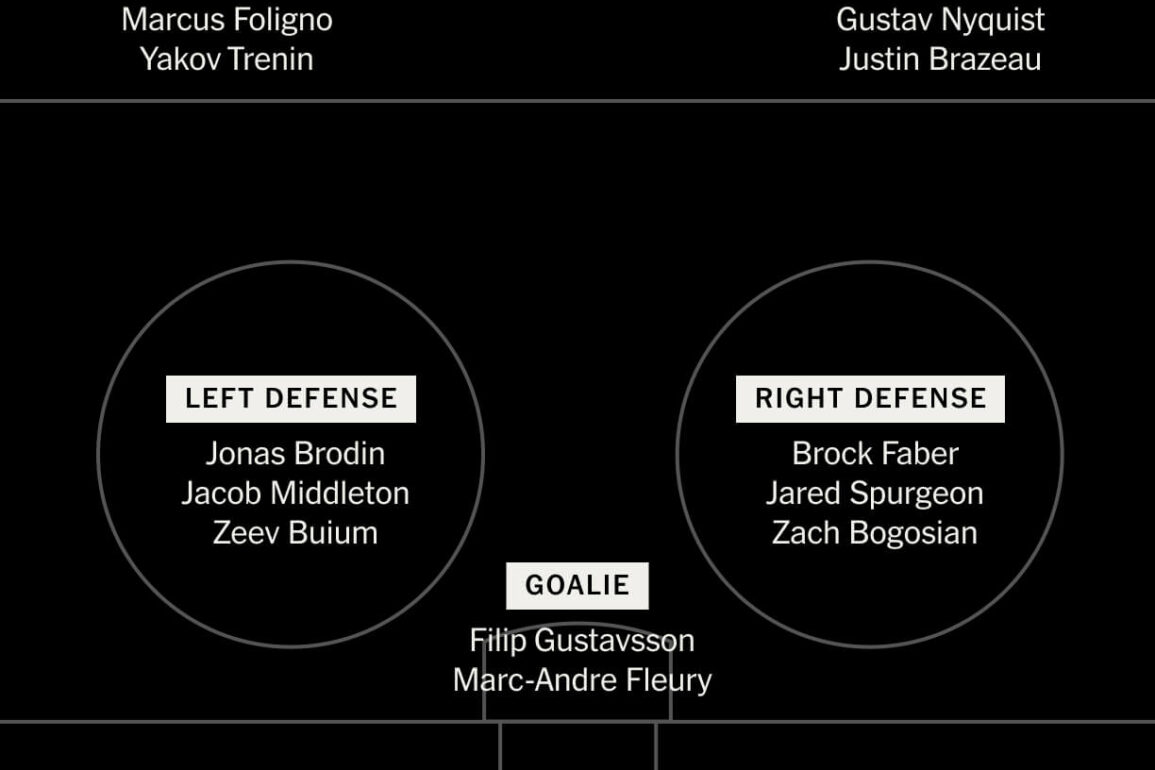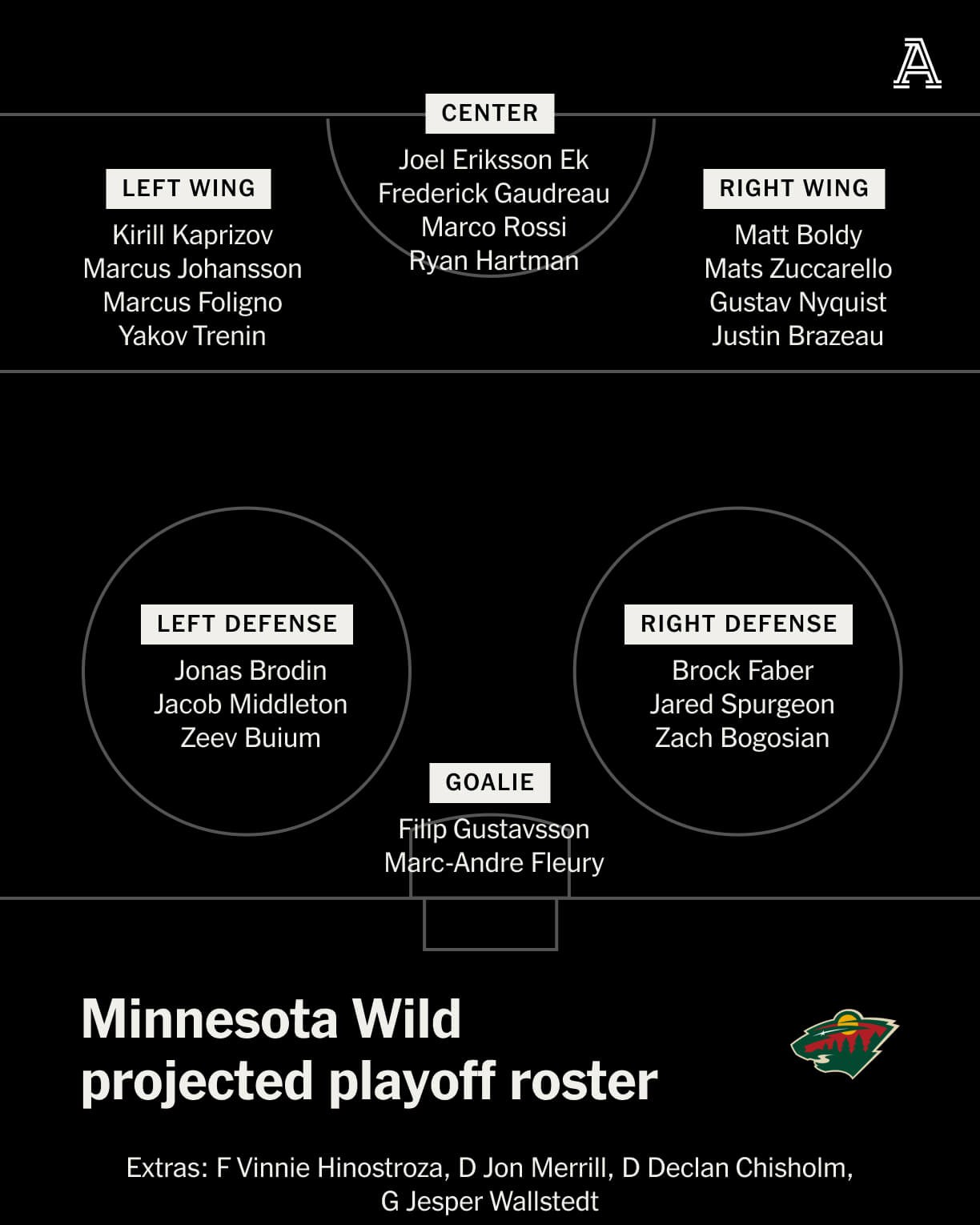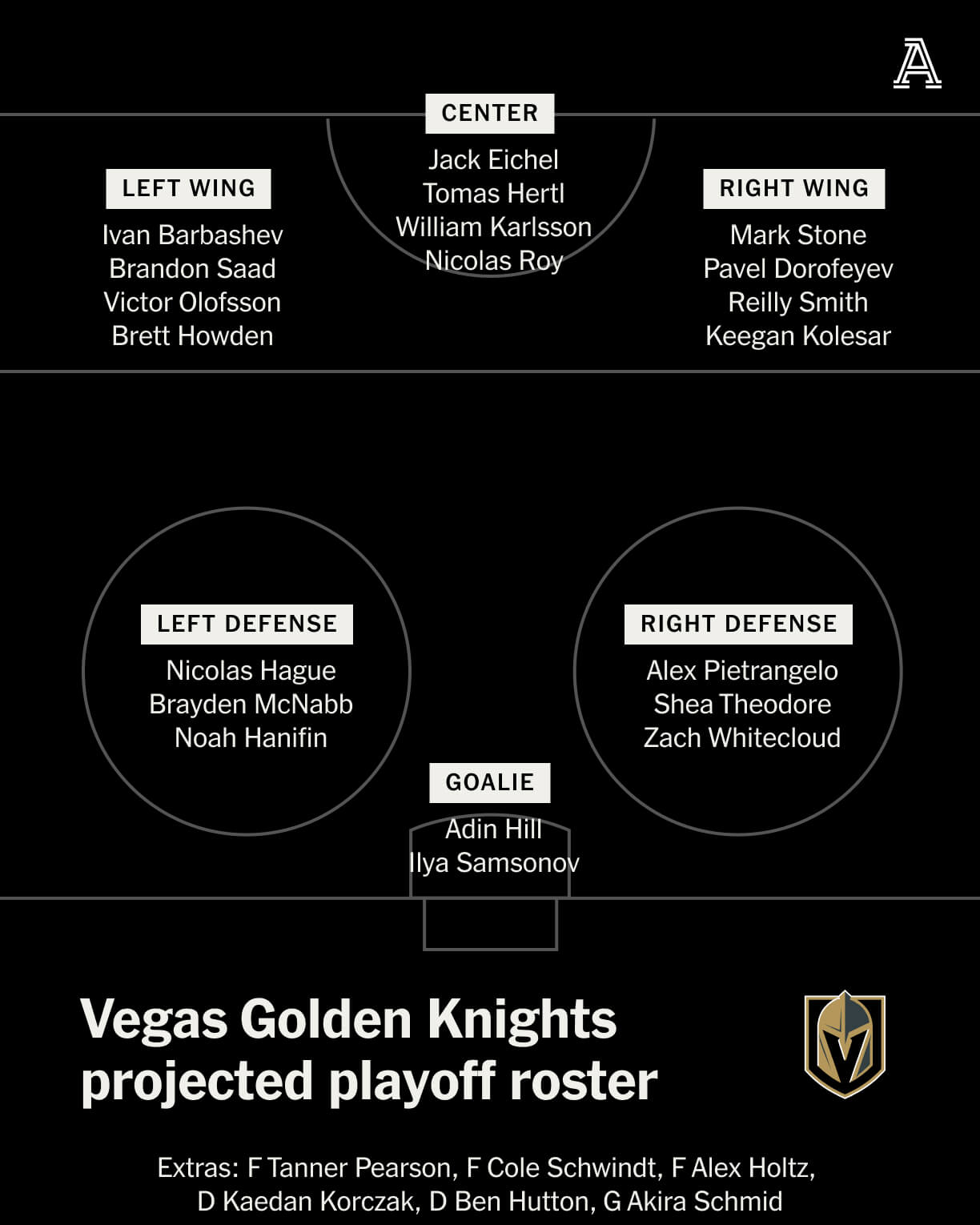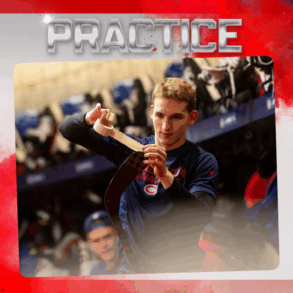By Michael Russo, Joe Smith and Jesse Granger
LAS VEGAS — Marc-Andre Fleury’s first big prank as a member of the Minnesota Wild was to white-out one of the pucks the Wild managed to get behind him when he backstopped the Vegas Golden Knights to a seven-game, first-round series victory over them in 2021.
Advertisement
After arriving in Minnesota from Chicago less than a year after ousting the Wild during his Vezina Trophy-winning season, Fleury couldn’t believe that one of the giant framed pictures hanging from a wall just inside the players’ entrance at the team’s practice rink was of Joel Eriksson Ek celebrating his Game 1 overtime winner, the only goal Fleury allowed in a 1-0 loss.
It took a while for his new teammates to notice, but one day Marcus Foligno walked into the practice facility, looked at the picture and realized “the puck was gone!”
“Yeah, every time I walked in I had to see Ek celebrating with the puck in the net,” Fleury said. “So I put (white) tape over it.”
Is the picture still hanging at the facility?
“No, it’s gone. I stole it,” Fleury said, jokingly … we think.
Four years after the Wild rallied from a 3-1 series deficit before losing in Game 7, the Wild return to Las Vegas to meet up with the Pacific Division champs in the first round starting Sunday.
The Golden Knights won the Stanley Cup two years ago. Seventeen players remain. They’ve won eight playoff series over the past five years, not including Fleury helping lead them to the Stanley Cup Final in their first year of existence in 2017-18.
“They’re one of the best teams the last couple years,” Wild star Kirill Kaprizov said. “You can see standings. This team play good every year. Should be a nice series.”
The Wild? While they’ve made the playoffs 11 times in the past 13 years — the most in the Western Conference in that span and tied for the most in the NHL — they haven’t advanced past the first round since 2015.
Despite having a series lead in each of their past four playoff appearances, they are the kings of the first-round exit, and this season they made the playoffs by the skin of their teeth.
Had Eriksson Ek not scored with 22 seconds left in regulation in Minnesota’s finale against Anaheim, they would have missed the playoffs thanks to Calgary winning its last two games.
Vegas went 50-22-10 for the third-most points in the NHL and were a dominant 29-9-3 at home. The Wild went 45-30-7 and were a pedestrian 21-17-2 at home. They were once the league’s best road team and they definitely play better on the road, going 23-13-5 (Vegas went 21-13-7).
The well-balanced Golden Knights averaged 3.34 goals per game, which ranked fifth in the NHL, and allowed just 2.61 goals per game – third-fewest in the league. The Wild were tied for 15th defensively at 2.88 goals per game, while offensively they averaged 2.74 goals per game — eighth-fewest in the NHL. But from Jan. 9 on, they were the league’s lowest-scoring team at 2.44 per game.
Advertisement
Of course, that was with a long list of injuries, including Kaprizov and Eriksson Ek being out of their lineup. They returned to play the season’s final four games and combined for seven goals.
Vegas also had the NHL’s second-best power play at 28.3 percent, while the Wild were 20th at 20.9 percent. Both team’s penalty kills left a lot to be desired, with Vegas finishing 26th at 75.7 percent and the Wild 30th at 72.4.
BetMGM has set the series odds for the Wild at +200, making them tied for the second-biggest underdogs in the first round with Montreal (vs. Washington). The biggest underdog is New Jersey, which is +230 to beat Carolina.
The Golden Knights also have won nine of the past 11 meetings against the Wild, including all three games this season, by a 12-4 combined score. In the last meeting, Jack Eichel lit up the Wild with a hat trick. Of course, in an oddity, the Wild were playing on the back half of back-to-back games in each of the meetings, and Kaprizov and Eriksson Ek only played one game each. In the first meeting, Kaprizov scored both of the Wild’s goals, and he has 10 goals and 15 points in 16 regular-season meetings against Vegas.
This will be a very different series than in 2021.
One big difference?
“More people,” Kaprizov said.
The 2021 series came at the end of a pandemic-shortened season in which the Wild and Golden Knights were aligned in the same division during a very weird year. The Golden Knights were allowed a T-Mobile Arena capacity of 8,683 for games 1 and 2, and 12,156 for games 5 and 7. The Wild were only allowed 4,500 inside Xcel Energy Center for games 3, 4 and 6.
“I just remember that series was physical,” Wild heavy hitter Marcus Foligno said. “We won Game 1, lost three, then climbed back with two, and then lost in Game 7. I think (Jonas Brodin) went down early. … They had Flower and now we’ve got Flower, so maybe that’s the lucky charm that we got this time. But, yeah, that was an intense series, and it was a lot of fun.”
Advertisement
One key to every series in Vegas is the atmosphere.
“It gets loud. Music’s loud, building’s loud,” Fleury said. “Lots of energy in the building. Sometimes you have to just breathe to stay relaxed a little bit and don’t be like going 100 mph everywhere. Be smart with energy and go at the right time and stay calm and try to play your regular game.”
Here are five burning questions heading into the series.
What’s the biggest matchup?
Wild: There are not many players in the world better than Kaprizov, but Eichel is also a top-10 player. He’s one of the best two-way centers, and a Selke candidate. And the biggest matchup will likely involve how to stop Eichel and the top line (which could include Mark Stone).
Expect a heavy dose of the defense pair of Brodin and Brock Faber. Eriksson Ek is the Wild’s Selke Trophy-caliber counterpart, though it’ll be interesting to see how much he and Eichel are matched up, especially on the road with Eriksson Ek centering the Wild’s top line with Kaprizov and Matt Boldy.
Faber has struggled this season against Eichel, with the Wild out-attempted 20-9 in the 21:25 ice time he saw against Eichel at five-on-five in the three meetings (31.03 Corsi For) per Natural Stat Trick. Brodin had a better number at 48.72 Corsi-For, out-attempted 20-19 in 20:40 TOI at five-on-five.
🌟 WHAT A MONTH FOR JACK EICHEL 🌟
👉 NHL-best 23 points in March (8G, 15A)
👉 13 points in the last six games (6G, 7A)
👉 Hat trick against Minnesota on March 25
👉 Seven multi-point games in March
👉 NHL’s 1st Star of the Month #VegasBorn pic.twitter.com/WJxTNDqRzX— y-Vegas Golden Knights (@GoldenKnights) April 1, 2025
But that doesn’t mean coach John Hynes will go away from Faber vs. Eichel. Faber averaged a career-high 25:32 and logged 27-plus minutes in each of the past three games.
Will Faber keep getting that heavy load?
“I think it will depend,” Hynes said. “When you come into these things, you play every game to win. You’ve got to try to do what’s required to win. No different than I think the players on the ice, when they’re playing the game, they’ve got to play the game that’s required to win — it’s about that game and nothing else. I think the same thing from a coaching perspective. You’re coaching to win that game. Those are decisions you’ve got to make.”
Advertisement
Golden Knights: William Karlsson has been a matchup weapon for the Golden Knights for the last eight seasons, and he should be again in this series. At his best, he’s the type of defensive centerman who can completely neutralize opposing stars. He did it against Connor McDavid in the second round in 2023, holding the Oilers scoreless in more than 28 minutes of even strength ice time against McDavid.
In the only meeting between Vegas and Minnesota this season with Kaprizov in the lineup (Dec. 15), Eichel saw more of Kaprizov’s line. That was in Minnesota, where coach Bruce Cassidy didn’t have last change, but based on Vegas’ current lineup, he will probably want to get Karlsson on the ice more often against the Wild’s top unit.
The last time Reilly Smith and William Karlsson played together at T-Mobile Arena:
— Danny Webster (@DannyWebster21) March 20, 2025
Karlsson is playing with reacquired Reilly Smith and Victor Olofsson, and Cassidy raves about the defensive abilities of both. Meanwhile, Eichel will be centering the top line with Stone and Ivan Barbashev. That line will be counted on to score more goals, so giving Karlsson’s line more defensive matchups would make sense.
The team gets in trouble when…?
Wild: When they try to play too much east-west hockey. There’s a good amount of skill on the Wild, from Kaprizov to Matt Boldy and Mats Zuccarello to Marco Rossi. But there’s a reason why the Wild may not open the series with Kaprizov and Zuccarello on the same line.
The Wild don’t play north enough to Hynes’ liking when they try to get too creative.
Of course, Kaprizov and Zuccarello also read off each other like few others in the NHL.
KAPRIZOV WINS IT IN OT IN HIS RETURN!! 🤯
The FIFTEENTH goal of the game is Kirill Kaprizov’s @Energizer overtime winner! pic.twitter.com/drDqddz0qq
— NHL (@NHL) April 10, 2025
The Wild are not the kind of team that can finesse and skate around opponents. They’ve been built on a certain commitment level and simplified game during the year, and it’ll have to carry them through. They absolutely have to get to the inside against the Golden Knights’ sizable blueliners.
“It’ll be big, to be able to get to the inside is where you have to score this time of year, unless there’s a major breakdown,” Hynes said. “We’ve got to skate. We’ve got to play fast in the offensive zone. I think it starts with a shot mentality, what we worked on (Thursday). You’ve got to have strong puck retrievals. You have to play direct. You have to deliver pucks to the net. You’ve got to have shots, shot attempts, rebounds, check it off sprays. Now they’ve got to come out of their structure, and then you have to attack quick.”
Advertisement
Golden Knights: It’s a similar story for Vegas. The rare stretches of poor hockey by the Golden Knights this season were almost always a product of mismanaging the puck through the neutral zone. Vegas’ zone defense is incredibly strong, so the easiest way to beat them is in transition off turnovers before the defense gets set up.
Both of these teams have good defensive structure and are stingy in transition, which means this series will likely become a waiting game, with the more patient team coming out on top. The team that blinks first, and tries to force plays that aren’t there, will end up making the mistakes that lose them the game.
“I think against this team, it’s going to be key to not turn the puck over and feed into their transition game,” Stone said. “We have to be patient. They play in a lot of low-scoring games, so you can’t force things. You have to just take what comes to you.”
Vegas scores a lot off the rush, so it won’t be easy to continually chip pucks behind defensemen and work on the forecheck, but that’s the game plan. They must trust that if they play a direct style of hockey, eventually the rush chances will present themselves.
“I think the only way we’re going to get our rush chances in this series is off of turnovers,” Stone said. “If it’s not there, we have to put the work boots on and go behind them.”
How do the goalies square up?
Filip Gustavsson
This was a strong year for Filip Gustavsson. He started the season red-hot, garnering some Vezina attention over the first few months. That slowed down over the second half, which obviously coincided with the Wild losing some key players due to injury.
Overall, the Wild should be happy with his form entering the playoffs, though. He’s about as technically sound of a goalie as you’ll find, rarely breaking structure even when plays break down right in front of the net. He’s not the fastest goalie but he makes up for that with good reads and smooth footwork.
Advertisement
One of Gustavsson’s biggest strengths is his ability to track pucks through traffic and control rebounds by either absorbing the puck for a whistle, or directing it out of harm’s way. Considering how goals are typically scored in the playoffs, these are great traits for a goalie to have. This save against Anaheim in the regular-season finale is a good example of a potentially dangerous play that Gustavsson extinguishes before it ever begins.
Anaheim had a player right in Gustavsson’s face to screen him on the initial shot and to be there for a dangerous put-back on the rebound. Not only did Gustavsson fight through traffic to track the puck, but he used his pad angle and momentum to turn it into a routine play with little danger. The exact same situation played with poor rebound control would’ve looked very different.
Gustavsson is a big reason Minnesota gave up the fifth-fewest rebound shots this season, and the fewest rebounds above expected according to MoneyPuck. His strong positioning helps him stick with pucks off his body. The speed in which he tracks pucks off his body and rotates to square himself to them is impressive. His eyes and shoulders are glued to every puck as it comes off his pads.
If the Golden Knights are going to beat Gustavsson in this series, it’ll be easiest off the rush. Vegas is one of the most dangerous rush teams in the league, and will need to use speed in transition and lateral passes to get Gustavsson out of position. Once the puck is established in the zone, he reads the play so well that you’ll rarely catch him out, but when the play is coming at him quickly, he can struggle to stay ahead of it.
Adin Hill
This was Hill’s best season yet, with new career-highs in starts, wins and shutouts. He was particularly good following the 4 Nations Face off, as he went 12-3-1 with a .920 save percentage down the stretch. One of Hill’s biggest problems in his NHL career has been a lack of durability, but after working hard in the summer and changing his strength program, he stayed healthy for the entire season for the first time. The more he played, the more confident he looked, and that’s the biggest takeaway from his current form.
Hill is a big goalie at 6-foot-4, 215 pounds, and he maximizes that frame with a confident playing style in which he isn’t afraid to stand his ground and challenge shooters. This save on Nashville defenseman Justin Barron is a good example of how Hill uses layers to cut off shooting angles.
Hill gets across quickly and sets his feet at the top of his crease. With the shooter approaching with this kind of speed, it would be easy for the goalie to flow with the play and back into his net, but Hill digs his edges in, stays on his toes and keeps a forward lean with his body to make himself bigger. Equally important, he keeps his gloves out in front of his body to crowd the puck, and give Barron layers of pads to beat for the goal. It makes the save look easy.
Hill has been outstanding in his limited playoff experience, with a .932 save percentage in 17 games. If the Wild are looking for a weakness, Hill’s rebound control has been pedestrian this season, and the Golden Knights have allowed the sixth-most rebound goals this season. It won’t be easy getting to the inside ice against Vegas’ hefty blueliners, but if the Wild can do it, there are goals to be had.
Advertisement
Which player has the most to prove?
Wild: After a terrific rookie season last year with 21 goals and 40 points, 23-year-old Marco Rossi followed it up with 24 goals and 60 points this year in a second straight 82-game season.
He spent a large part of the year on the top line, but of late he has been playing on the third line with Foligno and Gustav Nyquist, and when the going gets tough, he hasn’t played a lot of five-on-five late in games. Power play, six-on-five, overtime, he gets on the ice. But it was interesting how Hynes essentially benched him during large spurts of the third period recently in Vancouver.
THAT’S A WILD OT WIN! 🤩
Marco Rossi wins it for the @mnwild in @Energizer overtime! pic.twitter.com/JxX3e61bVh
— NHL (@NHL) April 6, 2025
This is going to be a big playoff debut for Rossi to prove that he can perform in intense, physical games and continue to go to the dirty areas and play with the pace needed. He’s a pending restricted free agent who is going to command a lot of money this offseason, so if his future isn’t going to be on the No. 1 power play or in the top-six, it’s very possible the Wild look to trade him this offseason.
There’s no doubt Rossi hasn’t been the same player since the 4 Nations Face-Off. Asked what Rossi has to get back to, Hynes said, “I think his competitive nature on the puck, to get over pucks, win puck battles offensively, be an elusive player, second and third effort on pucks, to allow him and his line to be able to play in the offensive zone. And there’s gotta be a willingness to get into the net front. That’s what this time of year requires from everyone.”
Golden Knights: It was an impressive breakout season for Pavel Dorofeyev. The 24-year-old winger led Vegas with 35 goals, up from 13 in 2023-24. He has one of the trickiest releases for goalies to read in all of the NHL and became a major weapon on the weak side of the Golden Knights’ second-ranked power-play unit.
The question is: Can he do it in the playoffs?
In each of the last two postseasons, Cassidy has been reluctant to play Dorofeyev. In 2022-23, Dorofeyev became a regular in the Golden Knights’ lineup down the stretch of the regular season, playing in 15 of the last 16 games. When the playoffs arrived, he was a healthy scratch for all 22 games. In 2023-24, Dorofeyev became an even bigger part of Vegas’ lineup, playing in 47 games, including 14 straight to end the regular season. When the playoffs arrived, Cassidy scratched him for six of the seven games against Dallas. In the only game he did play — a Game 5 loss — Dorofeyev saw only seven minutes of ice time.
What a year it has been for Pavel Dorofeyev. A team needing to replace the production that Marchessault provided, now has founded a forward with 34 goals this season @SportingTrib | #VegasBorn https://t.co/8hd9iWgpoW
— James Newell (@JamesNewell96) April 16, 2025
All of this is to say, it’s clear Cassidy didn’t believe Dorofeyev’s overall game was quite ready for playoff hockey. This season, Dorofeyev will be playing in every playoff game, and the Golden Knights are counting on him to score.
“He’s had a great year, so there’s no reason why he can’t continue doing what he does,” Cassidy said Friday. “He just might not do it at the same numbers level, because it’s hard. He might do more. Who knows? I’m not putting a ceiling on the guy.”
Advertisement
What’s the toughest lineup decision?
Wild: The Wild need some pizzazz in the lineup, a guy who can get the puck on the attack, a power-play dynamo.
That’s not Jon Merrill.
So enter 19-year-old Zeev Buium, fresh off his Frozen Four semifinal loss in St. Louis with the University of Denver. The 2024 first-round pick, 2024 NCAA champion and two-time World Juniors gold medalist with the United States looks like he’ll be a generational talent from the back end.
It also looks like he’ll become the first Wild player in history to make his NHL debut in the playoffs. The Wild took Friday off, but on Thursday in St. Paul, he quarterbacked the No. 1 power-play unit with Kaprizov, Eriksson Ek, Zuccarello, and Boldy and took Merrill’s spot on the third defense pair with Zach Bogosian.
Hynes says he’ll officially announce Saturday whether Buium will debut, but it’s clear he’ll get in at some point even if it’s not Game 1.
Golden Knights: With Vegas’ lineup as healthy as it has been all season, Cassidy’s toughest decision was who to sit. It came down to a choice between veteran Tanner Pearson and Olofsson on the wing, and Cassidy is going to play Olofsson — at least for Game 1.
Pearson has been a steady presence for Vegas all season after joining on a PTO in preseason and eventually signing a one-year contract. The former Cup champion with the Kings pitched in 12 goals and 15 assists playing mostly in the bottom-six. He will likely find his way into the lineup at some point but will start the playoffs as a healthy scratch.
Olofsson missed a big chunk of the season with a leg injury, but when he was healthy, he was a relatively consistent scoring threat for Vegas. He scored 15 goals in 56 games and has already shown good chemistry with Karlsson and Smith, with whom he’ll play to start. Cassidy is clearly looking for offense with this decision.
(Top photo from the 2021 playoffs: Ethan Miller / Getty Images)
This post was originally published on this site be sure to check out more of their content.












